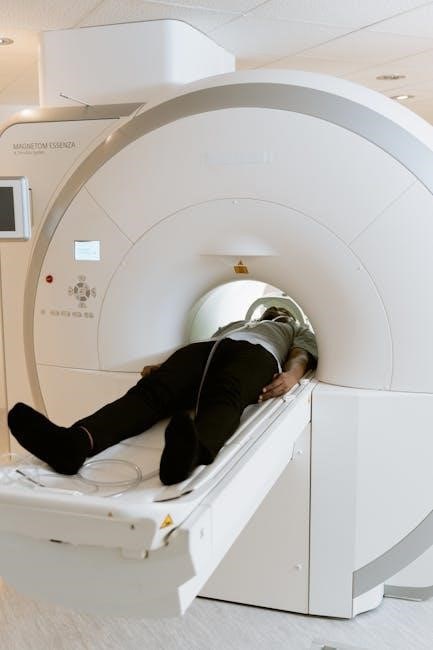The DISC Assessment is a behavior evaluation tool rooted in William Marston’s theory, focusing on four personality traits: Dominance, Influence, Steadiness, and Conscientiousness. It helps individuals understand their behavioral styles and improve personal and professional interactions.
1.1 Overview of DISC Personality Test
The DISC personality test is a behavioral assessment tool designed to identify individual styles based on four primary traits: Dominance (D), Influence (I), Steadiness (S), and Conscientiousness (C). It evaluates how individuals perceive situations and interact with others. The test typically involves a series of questions that measure preferences for directness, openness, consistency, and precision. Results are displayed on a personalized profile, highlighting strengths, challenges, and tendencies. This tool is widely used for personal development, team building, and leadership training. By understanding one’s DISC style, individuals can enhance communication, improve relationships, and align their behaviors with organizational goals. The test is straightforward, taking about 15-20 minutes to complete, and provides actionable insights for growth.
1.2 Importance of DISC Assessment in Personality Development
The DISC assessment plays a crucial role in personality development by providing insights into an individual’s behavioral tendencies and preferences. It helps identify strengths and areas for improvement, enabling personal growth and self-awareness. By understanding their DISC style, individuals can enhance communication skills, improve relationships, and adapt to different social and professional environments. The assessment also aids in leadership development, conflict resolution, and team collaboration, making it a valuable tool for both personal and professional development. Its practical applications ensure that individuals can align their behaviors with their goals, fostering a more effective and fulfilling life. Regular use of DISC assessments can lead to sustained personal and professional growth.
1.3 Brief History and Evolution of DISC Theory
The DISC theory was first introduced by psychologist William Moulton Marston in his 1928 book, Emotions of Normal People. Marston proposed that human behavior could be categorized into four primary styles: Dominance (D), Influence (I), Steadiness (S), and Conscientiousness (C). Initially, the theory was used to understand emotional responses and interpersonal dynamics. Over time, the DISC model evolved into a practical tool for personality assessment, widely adopted in corporate and educational settings. Modern versions of the DISC assessment incorporate advanced scoring systems and personalized reports, making it a versatile instrument for self-awareness, leadership development, and team building. Its evolution reflects its adaptability to changing societal and workplace needs.

Understanding the Four DISC Personality Traits
The DISC model identifies four core personality traits: Dominance (D), Influence (I), Steadiness (S), and Conscientiousness (C). These traits help individuals understand their behavior, communication style, and workplace interactions, fostering personal and professional growth.
2.1 Dominance (D), Characteristics and Strengths
The Dominance (D) trait in the DISC assessment represents individuals who are assertive, decisive, and results-driven. These individuals thrive in control and are naturally competitive, often taking charge in leadership roles. Their strengths include a strong focus on achieving goals and overcoming challenges, making them effective problem solvers. People high in Dominance are confident, action-oriented, and adept at making quick decisions. However, they may struggle with patience and may come across as overly direct or forceful. Understanding the D style helps individuals leverage their natural leadership abilities while developing empathy and collaboration skills to enhance teamwork and relationships. This trait is crucial for initiating projects and driving progress in both personal and professional settings.
2.2 Influence (I) — Traits and Workplace Implications
The Influence (I) trait in the DISC assessment reflects individuals who are outgoing, enthusiastic, and people-oriented. These individuals excel at communication, building relationships, and motivating others; In the workplace, they thrive in roles that involve collaboration, teamwork, and inspiring others. Their strengths include being approachable, optimistic, and adept at conflict resolution. However, they may struggle with focusing on details or making tough decisions without input from others. Understanding the I style helps individuals leverage their natural ability to connect with others while developing strategies to balance their sociable nature with task-oriented responsibilities. This trait is vital for fostering a positive work environment and encouraging open communication.
2.3 Steadiness (S) ⎼ Behavior Patterns and Weaknesses
The Steadiness (S) trait in the DISC assessment represents individuals who are consistent, reliable, and detail-oriented. These individuals value stability, loyalty, and long-term relationships. They excel in roles requiring patience, persistence, and a methodical approach. Their strengths include being good listeners, team players, and dependable. However, their cautious nature can sometimes lead to indecision or resistance to change. In the workplace, they may struggle with delegating tasks or adapting to sudden shifts in priorities. Understanding the S style helps individuals harness their stability while developing flexibility and confidence in decision-making. This trait is essential for maintaining harmony and consistency within teams and organizations.
2;4 Conscientiousness (C) — Key Features and Challenges
Conscientiousness (C) in the DISC assessment reflects a detail-oriented, organized, and thorough approach to tasks. Individuals high in C value accuracy, structure, and adherence to standards. They excel in roles requiring precision, planning, and reliability. Their strengths include being analytical, dependable, and committed to quality. However, challenges may arise from their tendency to be overly critical, perfectionistic, or resistant to change. They may also struggle with delegation due to high personal standards. Understanding the C style helps individuals balance their need for control with flexibility and collaboration. This trait is crucial for maintaining high standards and ensuring thoroughness in both personal and professional settings.

The DISC Assessment Process
The DISC assessment involves a series of questions evaluating behavioral preferences, typically completed online or on paper. It measures dominance, influence, steadiness, and conscientiousness, providing a personalized profile.
3.1 How to Take the DISC Personality Test
The DISC personality test is typically administered online or via paper, consisting of around 80 questions. It assesses behavioral preferences across four categories: Dominance, Influence, Steadiness, and Conscientiousness. Test-takers are asked to select adjectives that best and least describe them, ensuring honest responses for accurate results. The process usually takes 15-20 minutes, with some versions offering adaptive questioning for deeper insights. Upon completion, participants receive a personalized profile outlining their primary and secondary traits, along with strategies for improvement. The test is designed to be straightforward, requiring no prior preparation, and focuses on observable behaviors rather than hidden motivations. This makes it accessible and practical for both personal growth and workplace applications.
3.2 Scoring and Interpreting DISC Results
The DISC assessment is scored by evaluating responses to 80 questions, categorizing individuals into four primary traits: Dominance (D), Influence (I), Steadiness (S), and Conscientiousness (C). Each trait is assigned a score based on the frequency of selected adjectives. The highest and second-highest scores determine the dominant personality style, which may also include blends, such as D/IC or I/S. Results are interpreted to identify strengths, challenges, and preferred environments. Personalized profiles provide actionable insights, helping individuals enhance communication, leadership, and teamwork. The scoring system ensures clarity, while the interpretation focuses on practical application, making it a valuable tool for personal and professional growth. This process highlights how behaviors align with workplace dynamics and interpersonal interactions.
3.3 Understanding Your Personalized DISC Profile
A personalized DISC profile provides a detailed overview of an individual’s behavioral style, highlighting strengths, challenges, and preferred communication methods. The profile categorizes individuals into four main traits—Dominance (D), Influence (I), Steadiness (S), and Conscientiousness (C)—and may include blends, such as D/IC or I/S, indicating a combination of traits. It also outlines motivational drivers, potential stressors, and ideal work environments. By understanding their profile, individuals can identify how their behaviors align with their strengths and weaknesses, fostering personal growth and improved interactions. The profile serves as a practical guide for enhancing leadership, communication, and teamwork, making it a valuable tool for both personal and professional development. This personalized insight helps individuals leverage their unique style to achieve greater effectiveness in various contexts.

Applying DISC in Real-World Scenarios
The DISC assessment is widely used to enhance communication, improve teamwork, and develop leadership skills in various professional and personal contexts. It helps individuals adapt their behaviors to better interact with others, fostering collaboration and reducing conflicts. By understanding individual styles, organizations can create tailored strategies for employee development, customer service, and conflict resolution, ensuring more effective and harmonious interactions. This practical application makes DISC a valuable tool for real-world challenges, enabling individuals and teams to achieve greater success and satisfaction in their endeavors.
4.1 Improving Communication with DISC Insights
Understanding the DISC personality traits—Dominance, Influence, Steadiness, and Conscientiousness—provides valuable insights for enhancing communication. By recognizing individual styles, individuals can tailor their approach to align with others’ preferences, fostering mutual understanding. For instance, a Dominance-style person may prefer direct and concise interactions, while a Steadiness-style individual may appreciate a more patient and supportive tone. Leveraging these insights helps reduce misunderstandings and builds stronger relationships. Organizations can use DISC to train employees in adaptive communication, ensuring clearer messaging and improved collaboration. Personalized communication strategies, based on DISC profiles, empower individuals to connect more effectively, whether in personal or professional settings, leading to greater productivity and harmony.
4.2 Enhancing Team Collaboration Using DISC
The DISC assessment is a powerful tool for improving team collaboration by fostering mutual understanding and leveraging diverse strengths; By identifying each team member’s personality style—Dominance, Influence, Steadiness, or Conscientiousness—teams can better align roles with individual strengths. For example, a Dominance-style individual may excel in leadership roles, while a Steadiness-style person may thrive in supportive, stabilizing positions. Understanding these differences helps reduce friction and enhances teamwork. Teams can use DISC insights to assign tasks effectively, ensuring balanced contributions and improved efficiency. This approach not only boosts productivity but also strengthens interpersonal relationships, creating a more cohesive and harmonious work environment. Effective collaboration is achieved when each member’s unique traits are valued and utilized strategically.
4.3 Leadership Development Through DISC Assessment
The DISC assessment plays a pivotal role in leadership development by providing insights into a leader’s behavioral tendencies and how they impact team dynamics. Leaders can identify their dominant traits, such as Dominance (D) for assertive decision-making or Influence (I) for inspiring others, and learn to adapt these traits to various situations. DISC helps leaders recognize their strengths, like a Steadiness (S) style fostering loyalty and stability, and address potential weaknesses, such as over-reliance on Conscientiousness (C) leading to analysis paralysis. By understanding their DISC profile, leaders can refine their communication, delegation, and conflict-resolution skills, ultimately enhancing their ability to motivate and guide their teams effectively. Tailored development strategies based on DISC insights empower leaders to achieve greater success and create a positive organizational culture.
DISC and Workplace Dynamics
DISC insights enhance workplace communication, teamwork, and conflict resolution by aligning employee roles with their natural behaviors, fostering engagement and productivity.
5.1 Identifying Team Roles with DISC
The DISC assessment is a valuable tool for identifying team roles by analyzing individual behavioral styles. Each style—Dominance (D), Influence (I), Steadiness (S), and Conscientiousness (C)—brings unique strengths to a team. For instance, D-style individuals often excel in leadership roles, driving decision-making and goal achievement. I-styles thrive in communication and morale-boosting, making them ideal for team coordination. S-styles provide stability and consistency, ensuring tasks are completed thoroughly. C-styles focus on quality and accuracy, excelling in planning and problem-solving. By understanding these styles, organizations can align roles with natural behaviors, fostering collaboration and productivity. This alignment ensures that each team member contributes effectively, leveraging their strengths for collective success.
5.2 Conflict Resolution Strategies Based on DISC
The DISC assessment provides insights into conflict resolution by understanding individual behavioral styles. D-styles prefer direct, action-oriented approaches, often taking charge to resolve issues quickly. I-styles focus on collaboration and maintaining harmony, encouraging open dialogue to find mutually beneficial solutions. S-styles prioritize stability and may seek consensus to avoid conflict escalation, while C-styles analyze situations thoroughly, offering structured and logical resolutions. By tailoring strategies to these styles, conflicts can be addressed more effectively. For example, involving D-styles in decision-making and I-styles in communication can enhance resolution processes. Understanding these preferences fosters a balanced approach to conflict, ensuring all perspectives are considered and resolutions are sustainable. This method promotes teamwork and reduces friction in interpersonal and professional settings.
5.3 Employee Engagement and DISC Alignment
The DISC assessment plays a pivotal role in enhancing employee engagement by aligning individual behavioral styles with organizational goals. D-style employees thrive in challenging roles that allow them to take charge, while I-styles are motivated by collaborative and social environments. S-styles prefer stable and supportive settings, where they can maintain harmony. C-styles excel in structured roles with opportunities for analysis and precision. By understanding these preferences, organizations can create tailored strategies to boost engagement. For instance, offering growth opportunities for D-styles, fostering teamwork for I-styles, providing consistent feedback for S-styles, and ensuring clarity for C-styles. This alignment not only enhances productivity but also fosters a sense of fulfillment, leading to higher retention and overall job satisfaction.
Advanced DISC Concepts
Exploring sub-styles, adaptive behaviors, and environmental influences deepens understanding of DISC. These advanced concepts reveal nuanced personality traits, enhancing personal growth and professional development strategies.
6.1 Understanding DISC Sub-styles and Blends
DISC sub-styles and blends offer deeper insights into personality by combining primary traits. Sub-styles emerge when two primary styles are equally dominant, creating unique behavioral patterns. For instance, a D/I blend may exhibit assertiveness and charisma, while a C/S blend might balance caution with reliability. These combinations influence how individuals interact and make decisions. Recognizing sub-styles enhances self-awareness and improves interpersonal dynamics. Each blend has distinct strengths, such as the D/C style’s strategic thinking or the I/S style’s empathetic communication. Understanding these nuances allows for tailored personal and professional development strategies. By identifying sub-styles, individuals can adapt their behaviors to align with their environment, fostering effectiveness in various contexts. This advanced understanding of DISC enriches personality insights.
6;2 Adaptive vs. Natural DISC Styles
The DISC assessment distinguishes between natural and adaptive styles, revealing how individuals behave inherently versus how they adjust to environments. Natural styles reflect core tendencies, while adaptive styles show how people modify their behavior to fit situations. For example, someone with a natural C style may adapt to a more D style in high-pressure scenarios. Understanding this duality helps identify flexibility and growth potential. Assessments like Everything DiSC provide insights into both natural and adaptive behaviors, enabling individuals to align their actions with their true strengths while developing new skills. Recognizing these distinctions fosters personal growth, improves relationships, and enhances professional effectiveness by bridging the gap between innate traits and learned behaviors.
6.3 The Role of Environment in Shaping DISC Behavior
The environment plays a significant role in shaping DISC behaviors, as individuals often adapt their natural styles to fit external circumstances. For instance, someone with a natural C (Conscientiousness) style may exhibit more D (Dominance) traits in fast-paced, competitive environments to meet demands. Conversely, a person with a natural D style might adopt S (Steadiness) behaviors in collaborative, team-oriented settings to foster harmony. Environmental factors, such as workplace culture, leadership styles, and social dynamics, can influence how individuals express their DISC traits. Understanding this interplay helps individuals and organizations create environments that align with natural behaviors, fostering productivity and well-being. By recognizing environmental impacts, individuals can better navigate diverse situations and optimize their behavioral responses for success.
Case Studies and Practical Examples
Real-world applications of the DISC assessment reveal its practical benefits, such as improving leadership, enhancing team dynamics, and fostering personal growth through tailored behavioral insights.
7.1 Successful Leadership Using DISC Insights
The DISC assessment has proven instrumental in fostering effective leadership by providing insights into personal behavioral styles. Leaders who understand their DISC profile can adapt their communication strategies to inspire and motivate their teams. For instance, a leader with a dominant (D) style may learn to balance assertiveness with empathy, while an influential (I) leader can refine their approach to encourage collaboration. Case studies highlight leaders who, by leveraging DISC insights, achieved significant improvements in team morale, productivity, and conflict resolution. By aligning their leadership style with the needs of their team, these leaders created a more cohesive and productive work environment, demonstrating the practical value of DISC in real-world leadership scenarios.
7.2 Team Building Exercises with DISC Assessment
DISC assessments are widely used in team-building exercises to foster collaboration and mutual understanding. By identifying individual behavioral styles, team members gain insights into how their colleagues prefer to communicate and work. For example, a team with diverse DISC profiles can engage in workshops where each member shares their strengths and challenges, promoting empathy and cooperation. Activities such as role-playing or group tasks tailored to DISC styles help teams leverage their collective strengths. This approach enhances communication, reduces conflicts, and boosts productivity. Recognizing and valuing each person’s unique contributions creates a more inclusive and effective team dynamic, making DISC a powerful tool for building cohesive and high-performing teams.
7.3 Personal Growth Stories Through DISC Understanding
Personal growth through DISC understanding often begins with self-awareness, as individuals gain clarity on their behavioral strengths and areas for improvement. Many have shared stories of how DISC insights transformed their lives, enabling better communication and decision-making. For instance, individuals with a dominant “D” style may learn to balance assertiveness with empathy, while those with a “C” style might focus on delegating tasks more effectively. By identifying their unique DISC profiles, people can set personalized goals, fostering confidence and resilience. These stories highlight how embracing one’s DISC style leads to meaningful personal and professional development, empowering individuals to navigate challenges and achieve their full potential.

Criticisms and Limitations of DISC
The DISC model has faced criticism for lacking empirical support and being overly simplistic. Some argue it overlooks complexity in human behavior, relying on forced-choice responses;
8.1 Common Criticisms of the DISC Model
The DISC model has faced criticism for its lack of strong empirical support and oversimplification of human behavior. Critics argue that it fails to account for the complexity and nuance of personality, as it categorizes individuals into just four broad traits. Additionally, the forced-choice format of the assessment can lead to inaccurate results, as respondents may feel pressured to choose between options that don’t fully capture their behaviors. The model’s reliance on self-reporting also raises concerns about bias and the potential for respondents to answer idealistically rather than honestly. Furthermore, some researchers have questioned the model’s validity and reliability compared to more comprehensive personality assessments. These criticisms highlight the need for careful consideration when using DISC in professional or personal development contexts.
8.2 Comparing DISC with Other Personality Assessments
The DISC assessment is often compared to other personality tests like Myers-Briggs and the Big Five Inventory. Unlike Myers-Briggs, which focuses on psychological types, DISC emphasizes observable behaviors and workplace interactions. While the Big Five model offers a more detailed analysis of personality traits, DISC is praised for its simplicity and practicality in professional settings. DISC’s focus on behavior rather than underlying traits sets it apart from more complex assessments. However, critics argue that DISC oversimplifies personality, lacking the depth of models like the Big Five. Despite this, DISC remains popular for its ease of use and direct applicability in team building and leadership development. Its clear categories make it accessible for many organizations seeking to improve communication and collaboration.
8.3 Addressing the Limitations of DISC in Modern Contexts
While the DISC assessment remains a popular tool for understanding behavior, it has limitations in modern contexts. Critics argue that its simplicity oversimplifies complex personalities, potentially neglecting deeper psychological traits. Additionally, DISC lacks strong empirical support compared to other models like the Big Five Inventory. In today’s diverse and dynamic workplaces, there is a growing need for assessments that account for cultural and contextual factors. To address these limitations, organizations can combine DISC with other assessments for a more comprehensive understanding. Moreover, focusing on adaptive styles rather than static traits can enhance its relevance. By integrating DISC with modern psychological insights, its practicality and effectiveness in contemporary settings can be strengthened. This balanced approach ensures DISC remains a valuable tool in evolving professional environments.
The DISC assessment is a valuable tool for understanding personality and behavior, offering insights into communication, teamwork, and leadership. By applying its principles, individuals and organizations can foster growth and collaboration. For further development, explore additional resources and training to deepen your understanding of DISC principles and their practical applications.
9;1 Summarizing the Value of DISC Assessment
The DISC assessment is a powerful tool for understanding personality and behavior, offering insights into communication, teamwork, and leadership. By evaluating individual styles—Dominance, Influence, Steadiness, and Conscientiousness—it provides a framework for personal and professional growth. The assessment helps identify strengths and areas for improvement, fostering self-awareness and empathy. Organizations benefit by improving collaboration, resolving conflicts, and aligning roles with employee personalities. Its practical applications make it invaluable for enhancing workplace dynamics and individual performance. Ultimately, the DISC assessment empowers individuals and teams to leverage their unique traits, leading to more effective interactions and a more productive environment.
9.2 How to Implement DISC in Your Organization
Implementing DISC in your organization begins with administering the assessment to all team members to identify individual personality traits. Provide training sessions to help employees understand their profiles and how to interpret the results effectively. Encourage open discussions about how different DISC styles can complement each other, fostering a collaborative environment. Use the insights to align roles with strengths and preferences, enhancing productivity and job satisfaction. Develop targeted leadership programs based on DISC findings to improve communication and conflict resolution. Regularly review and update team dynamics to ensure optimal integration of DISC principles, leading to a more harmonious and efficient workplace culture. Continuous support and resources are essential for sustained success.
9.3 Further Resources for DISC Learning
To deepen your understanding of DISC, explore comprehensive resources like the DISC Assessment Scoring Guide PDF, which offers detailed insights into interpreting results. Online platforms such as Everything DiSC provide interactive tools and personalized profiles. Additionally, workbooks and guides, like the DISC Personality Test Word Doc, include practical exercises to enhance learning. Websites like Getting People Right offer cheat sheets and in-depth articles on DISC styles. For organizations, platforms like the Team Development Platform provide free trials and advanced analytics. Lastly, research papers and case studies, such as those by GK Beedu, explore the effectiveness and real-world applications of DISC assessments, ensuring a well-rounded understanding of the model.